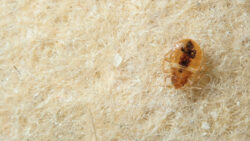Bed bugs are more than just a nuisance; they’re a serious problem that can disrupt your peace of mind and even pose health risks. Bed bugs can thrive if not properly addressed. Knowing how to spot the early signs of a bed bug infestation is crucial for timely intervention and control. In this guide, we’ll delve into the details of identifying bed bugs, recognizing signs of an infestation, understanding associated hazards, and taking appropriate action to deal with these unwelcome guests.
Where to Look for Bed Bugs
Bed bugs are adept at hiding in various nooks and crannies, making them challenging to detect. Common areas where bed bugs lurk include:
- Mattress Seams and Bedding: Check along mattress seams, particularly where fabric is stitched together, as bed bugs prefer to hide in these crevices. Inspect pillowcases, sheets, and blankets for any signs of bed bugs or their excrement.
- Bed Frame and Headboard: Bed bugs often reside in cracks, joints, and screw holes of bed frames and headboards. Examine these areas thoroughly, especially if they’re made of wood or have intricate designs.
- Furniture and Upholstery: Sofas, chairs, and other upholstered furniture provide hiding spots for bed bugs. Look beneath cushions, inside seams, and behind loose upholstery.
- Cracks and Crevices: Bed bugs can squeeze into tiny cracks and crevices in walls, floors, and furniture. Pay close attention to baseboards, electrical outlets, and wallpaper edges.
- Clothing and Luggage: Bed bugs can hitchhike on clothing and luggage, so inspect these items after traveling or staying in infested areas.
Signs of a Bed Bug Infestation
Identifying the early signs of a bed bug infestation is crucial for prompt action. Look out for the following indicators:
- Bite Marks: Bed bug bites typically appear as small, red, itchy welts on exposed areas of the skin, such as the face, neck, arms, and hands. However, not everyone reacts to bed bug bites, so you may not always see visible marks.
- Blood Stains: Crushed bed bugs may leave behind blood stains on bedding or furniture, resembling small rust-colored spots.
- Dark Spots: Bed bug feces, which consist of digested blood, appear as dark, ink-like stains on surfaces such as mattresses, sheets, or walls.
- Musty Odor: A strong, musty odor emanating from infested areas can be a sign of a large bed bug population, as they release pheromones that produce a distinctive smell.
- Presence of Bed Bug Eggs: Bed bug eggs are tiny, oval-shaped, and pearly white in color. They may be found individually or clustered together in groups.
Hazards Associated with Bed Bugs
While bed bugs are not known to transmit diseases, their presence can lead to several hazards, including:
- Skin Irritation: Bed bug bites can cause itching, swelling, and discomfort, leading to secondary infections if scratched excessively.
- Sleep Disturbance: The fear of being bitten by bed bugs can disrupt sleep patterns and lead to insomnia or anxiety.
- Psychological Impact: Dealing with a bed bug infestation can be emotionally taxing, causing stress, embarrassment, and a sense of invasion of privacy.
What to Do If You Have a Bed Bug Infestation
If you suspect a bed bug infestation in your home, it’s essential to take swift and effective action:
- Don’t Panic: Stay calm and avoid overreacting. Bed bugs can be eradicated with the right bed bug control plan.
- Inspect Thoroughly: Conduct a thorough inspection of your home to confirm the presence and extent of the infestation.
- Contact a Professional: Enlist the services of a reputable bed bug control company with experience in handling infestations. Professional exterminators have the expertise and resources to effectively eliminate bed bugs.
- Follow Treatment Recommendations: Cooperate with the pest control professionals and follow their recommendations for preparing your home and implementing treatment protocols.
- Monitor and Prevent Reinfestation: After treatment, monitor your home regularly for any signs of bed bugs and take preventive measures to avoid future infestations.
How to Prevent Bed Bugs
Prevention is key to avoiding the hassle and expense of dealing with a bed bug infestation. Here are some tips to keep bed bugs at bay:
- Inspect Secondhand Furniture: Before bringing used furniture or mattresses into your home, thoroughly inspect them for signs of bed bugs.
- Be Cautious When Traveling: Check hotel rooms for bed bugs before unpacking, and keep luggage elevated and away from beds and upholstered furniture.
- Regular Cleaning and Decluttering: Reduce hiding spots for bed bugs by regularly vacuuming carpets, washing bedding in hot water, and decluttering your home.
- Seal Cracks and Crevices: Seal cracks and crevices in walls, floors, and furniture to minimize hiding spots for bed bugs.
- Use Protective Covers: Encase mattresses and box springs with bed bug-proof covers to prevent infestations and make detection easier.
Early detection and swift action are essential when dealing with a bed bug infestation in Florida. By knowing where to look for early signs of bed bugs, recognizing indicators of an infestation, and taking preventive measures, you can protect your home and family from these unwanted pests. If faced with a bed bug problem, don’t hesitate to seek professional assistance to ensure thorough eradication and peace of mind. Remember, with diligence and proper precautions, you can keep bed bugs at bay and enjoy a bed bug-free environment.



